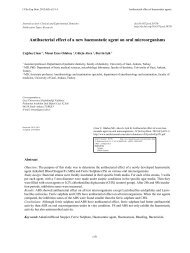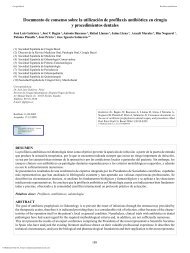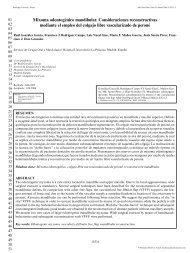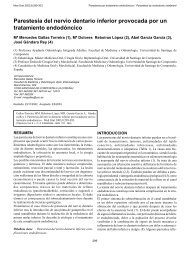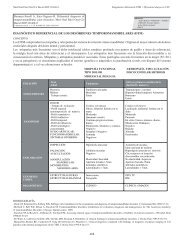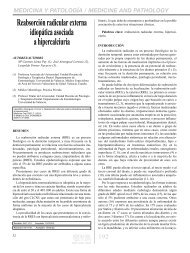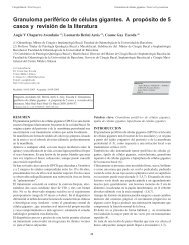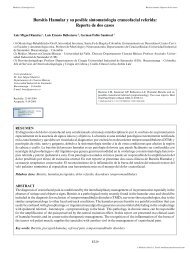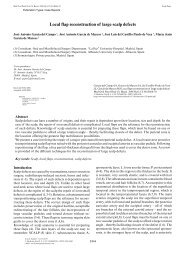Immediate implants following tooth extraction. A ... - Medicinaoral.com
Immediate implants following tooth extraction. A ... - Medicinaoral.com
Immediate implants following tooth extraction. A ... - Medicinaoral.com
You also want an ePaper? Increase the reach of your titles
YUMPU automatically turns print PDFs into web optimized ePapers that Google loves.
Med Oral Patol Oral Cir Bucal. 2012 Mar 1;17 (2):e251-61. <strong>Immediate</strong> <strong>implants</strong><br />
Journal section: Oral Surgery<br />
Publication Types: Review<br />
<strong>Immediate</strong> <strong>implants</strong> <strong>following</strong> <strong>tooth</strong> <strong>extraction</strong>. A systematic review<br />
Jordi Ortega-Martínez 1 , Tania Pérez-Pascual 2 , Santiago Mareque-Bueno 3 , Federico Hernández-Alfaro 4 ,<br />
Eduard Ferrés-Padró 5<br />
1 DDS, Master in Oral Implantology, PhD Student, Medicine, Surgery and Oral Implantology Department, Dental School, Inter-<br />
national University of Catalonia<br />
2 DDS, Master in Oral Implantology, PhD Student, Medicine, Surgery and Oral Implantology Department, Dental School, Inter-<br />
national University of Catalonia<br />
3 DDS, Master in Oral Implantology, A. Professor, Medicine, Surgery and Oral Implantology Department, Dental School, Inter-<br />
national University of Catalonia<br />
4 MD, DDS, PhD OMFS, Prof. And Director Master in Oral Implantology, Medicine, Surgery and Oral Implantology Department,<br />
Dental School, International University of Catalonia<br />
5 MD, DDS, PhD OMFS, Prof. And Head of Department of Medicine, Surgery and Oral Implantology Department, Dental<br />
School, International University of Catalonia<br />
Correspondence:<br />
Faculty of Dentistry<br />
Universitat Internacional de Catalunya<br />
Josep Trueta s/n<br />
08195 Sant Cugat del Vallès, Barcelona (Spain)<br />
jordi.om@hotmail.<strong>com</strong><br />
Received: 05/01/2011<br />
Accepted: 25/03/2011<br />
Ortega-Martínez J, Pérez-Pascual T, Mareque-Bueno S, Hernández-Alfaro<br />
F, Ferrés-Padró E. . <strong>Immediate</strong> <strong>implants</strong> <strong>following</strong> <strong>tooth</strong> <strong>extraction</strong>. A syste- systesystematic review. Med Oral Patol Oral Cir Bucal. 2012 Mar 1;17 (2):e251-61.<br />
http://www.medicinaoral.<strong>com</strong>/medoralfree01/v17i2/medoralv17i2p251.pdf<br />
Article Number: 17469 http://www.medicinaoral.<strong>com</strong>/<br />
© Medicina Oral S. L. C.I.F. B 96689336 - pISSN 1698-4447 - eISSN: 1698-6946<br />
eMail: medicina@medicinaoral.<strong>com</strong><br />
Indexed in:<br />
Science Citation Index Expanded<br />
Journal Citation Reports<br />
Index Medicus, MEDLINE, PubMed<br />
Scopus, Embase and Emcare<br />
Indice Médico Español<br />
Abstract<br />
Objectives: The aim of this article is to review the current state of immediate <strong>implants</strong>, with their pros and contras,<br />
and the clinical indications and contraindications.<br />
Material and Methods: An exhaustive literature search has been carried out in the COCHRANE library and ME-<br />
DLINE electronic databases from 2004 to November 2009. Randomized clinical trials and clinical trials focused<br />
on single <strong>implants</strong> placed in fresh <strong>extraction</strong> sockets were included and <strong>com</strong>pared. A meta-analysis could not be<br />
performed due to heterogeneity of the data.<br />
Results: Twenty studies out of 135 articles from the initial search were finally included, which summed up a total<br />
of 1139 immediate <strong>implants</strong> with at least a 12-month follow-up. Our results have been <strong>com</strong>pared with other current<br />
available papers in the literature reviewed that obtained similar out<strong>com</strong>es.<br />
Discussion: <strong>Immediate</strong> <strong>implants</strong> have predictable results with several advantages over delayed implant placement.<br />
However, technical <strong>com</strong>plications have been described regarding this technique. Also, biomaterials may be needed<br />
when the jumping distance is greater than 1mm or any bone defect is present.<br />
Conclusions: Few studies report on success rates rather than survival rates in the literature reviewed. Short-term<br />
clinical results were described and results were <strong>com</strong>parable to those obtained with delayed implant placement.<br />
Further long-term, randomized clinical trials are needed to give scientific evidence on the benefits of immediate<br />
<strong>implants</strong> over delayed implant placement.<br />
Key words: <strong>Immediate</strong> <strong>implants</strong>, fresh socket, dental <strong>implants</strong>, gap, jumping distance, implant stability.<br />
e251<br />
doi:10.4317/medoral.17469<br />
http://dx.doi.org/doi:10.4317/medoral.17469
Med Oral Patol Oral Cir Bucal. 2012 Mar 1;17 (2):e251-61 <strong>Immediate</strong> <strong>implants</strong><br />
Introduction<br />
Nowadays advances in clinical techniques and biomaterials<br />
have facilitated a great expansion in the indications<br />
for dental implant treatment options.<br />
Teeth replacement using dental <strong>implants</strong> has proven to<br />
be a successful and predictable treatment procedure; different<br />
placement and loading protocols have evolved<br />
from the first protocols in order to achieve quicker and<br />
easier surgical treatment times. <strong>Immediate</strong> placement<br />
of a dental implant in an <strong>extraction</strong> socket was initially<br />
described more than 30 years ago by Schulte and Heimke<br />
in 1976 (1).<br />
Reductions in the number of surgical interventions, a<br />
shorter treatment time, an ideal three dimensional implant<br />
positioning, the presumptive preservation of alveolar<br />
bone at the side of the <strong>tooth</strong> <strong>extraction</strong> and soft<br />
tissue aesthetics have been claimed as the potential advantages<br />
of this treatment approach (2).<br />
On the other hand, the morphology of the side, the<br />
presence of periapical pathology, the absence of keratinized<br />
tissue, thin tissue biotype and lack of <strong>com</strong>plete<br />
soft tissue closure over the <strong>extraction</strong> socket have been<br />
reported to adversely affect in immediately placed <strong>implants</strong><br />
(2).<br />
The first classification described the timing of implant<br />
placement as mature, recent, delayed or immediate<br />
depending on soft tissue healing and predictability of<br />
Guided Bone Regeneration (GBR) procedures, however<br />
further classifications based on hard and soft tissue<br />
healing and treatment time approach were subsequently<br />
described, as shown in (Table 1) (3,4).<br />
The efficacy of GBR therapy employing autogenous<br />
and non-autogenous particulate materials <strong>com</strong>bined<br />
with various membranes to regenerate alveolar bone at<br />
the time of <strong>tooth</strong> <strong>extraction</strong> has also been demonstrated.<br />
Con<strong>com</strong>itant placement of regenerative materials<br />
has been shown to result in predictable, high levels of<br />
osseointegration (5).<br />
This study will focus on the review of the current literature<br />
on immediate implant placement, in order to<br />
Table 1. Timing of implant placement.<br />
Author / Year Classification Implant placement<br />
Hämmerle et al. (2004) Type I In fresh <strong>extraction</strong> sockets<br />
e252<br />
understand <strong>extraction</strong> wound healing and crestal bone<br />
loss and the treatment of the jumping distance, as well<br />
as several treatment features that affect biological bone<br />
and soft tissue response <strong>com</strong>pared to the delayed placement<br />
protocol.<br />
The purpose of this review is to answer the <strong>following</strong><br />
questions:<br />
- Are there significant differences in crestal bone resorption<br />
between immediate and delayed <strong>implants</strong>?<br />
Where?<br />
- Do immediate <strong>implants</strong> have a significant effect on<br />
soft tissue recession out<strong>com</strong>es?<br />
- Does the presence of periapical infection have an effect<br />
on the immediate implant success or survival rate?<br />
- Does the gap treatment minimize crestal bone loss?<br />
- Are there any significant differences in implant stability<br />
between immediate and delayed <strong>implants</strong>?<br />
Material and Methods<br />
A well-focused question is a very significant step to guide<br />
a high- quality and clinically purposeful systematic<br />
review. The participant, intervention, <strong>com</strong>parison,<br />
out<strong>com</strong>e (PICO) approach has been developed to state<br />
the objectives and inclusion criteria into a clear structured<br />
question (6):<br />
Participants: Patients who needed immediate placement<br />
and restoration <strong>following</strong> <strong>extraction</strong> of a single <strong>tooth</strong>.<br />
Intervention: <strong>Immediate</strong> implant in different clinical<br />
situations; upper jaw, lower jaw, anterior or posterior sites,<br />
<strong>implants</strong> with or without guided bone regeneration,<br />
and with or without periapical pathology.<br />
Comparison: <strong>Immediate</strong> <strong>implants</strong> with or without guided<br />
bone regeneration, and immediate <strong>implants</strong> versus<br />
delayed <strong>implants</strong>.<br />
Out<strong>com</strong>e: <strong>Immediate</strong> implant survival and success rates,<br />
position of the mucosal margin, mean distance from<br />
buccal bone to lingual bone, marginal bone resorption,<br />
bone loss, and implant stability.<br />
Search Strategy & Study Selection:<br />
The MEDLINE (PubMed) and The Cochrane Library<br />
Type II After soft tissue coverage ( 4- 8 weeks)<br />
Type III Radiographic bone fill (12-16 weeks)<br />
Type IV Healed socket (>16 weeks)<br />
Esposito et al. (2006) <strong>Immediate</strong> In fresh <strong>extraction</strong> sockets<br />
<strong>Immediate</strong>-delayed < 8 weeks post <strong>extraction</strong><br />
Delayed > 8 weeks post <strong>extraction</strong>
Med Oral Patol Oral Cir Bucal. 2012 Mar 1;17 (2):e251-61. <strong>Immediate</strong> <strong>implants</strong><br />
Table 2a. Main inclusion criteria.<br />
databases were searched for articles published from<br />
2004 to November 2009. The search was also restricted<br />
to articles published in English. The <strong>following</strong> search<br />
terms were used in different <strong>com</strong>binations: immediate<br />
<strong>implants</strong>, <strong>extraction</strong> socket, fresh socket, dental <strong>implants</strong>,<br />
single implant, gap, jumping distance, implant<br />
stability.<br />
Thirty abstracts were finally selected from 135 titles in<br />
the initial search, and the full texts were obtained. Based<br />
on the evidence categories of the North of England<br />
Evidence Based Guideline Development Project (1996),<br />
only randomized clinical trials and prospective clinical<br />
trials were included in this review. Therefore, 10 articles<br />
were also excluded owing to the reasons shown in<br />
(Table 2a, b).<br />
The articles finally selected were published in the <strong>following</strong><br />
dental journals: International Journal of Oral<br />
and Maxillofacial Implants, Clinical Oral Implants Research,<br />
Journal of Oral and Maxillofacial Surgery, Implant<br />
Dentistry, Oral Surgery Oral Medicine Oral Pathology<br />
Oral Radiology and Endodontology, International<br />
Journal of Periodontics and Restorative Dentistry,<br />
Clinical Implant Dentistry and Related Research, and<br />
Journal of Clinical Periodontology, and were <strong>com</strong>pared<br />
with similar reviews from further journals.<br />
The review included studies of patients who needed <strong>tooth</strong><br />
<strong>extraction</strong> due to periapical infections, unrestorable<br />
caries, trauma or periodontal disease.<br />
When applicable, success rates found in articles were<br />
defined according to the criteria described by Albrektsson<br />
et al., which includes a reported absence of mobility,<br />
pain, peri-implant infection and suppuration, as well<br />
LIST OF MAIN INCLUSION CRITERIA<br />
Randomized Clinical Trial and Prospective Controlled Trial<br />
More than 12 months follow-up<br />
Over 10 <strong>implants</strong> sample<br />
Implant details described<br />
Jumping distance treatment options<br />
Implant stability details<br />
Presence/ Absence of periapical infection<br />
Table 2b. Main exclusion criteria.<br />
LIST OF MAIN EXCLUSION CRITERIA<br />
Unclear information about patient, implant, follow-up, study design<br />
Study in animals<br />
Case series/reports<br />
Other implant protocols (delayed placement)<br />
Being focused on patient satisfaction<br />
e253<br />
as radiographic peri-implant bone loss of
Med Oral Patol Oral Cir Bucal. 2012 Mar 1;17 (2):e251-61 <strong>Immediate</strong> <strong>implants</strong><br />
Fig. 1. Flow diagram for the search strategy<br />
�<br />
Articles Year Reasons for exclusion<br />
Table 3. List of excluded articles after the final selection.<br />
García et al (2009) Insufficient sample size<br />
Raghoebar et al (2009) Implants were placed after bone healing<br />
Kahngberg (2009) Clinical report<br />
Covani et al (2008) Short follow-up prospective trial (6 months)<br />
Canullo et al (2007) Insufficient sample size<br />
Cangini et al (2005) Clinical report<br />
Cornellini et al (2004) Short follow-up controlled clinical trial (6 months)<br />
Covani et al (2004) Short follow-up prospective trial (6 months)<br />
Botticelli et al (2004) Short follow-up prospective trial (4 months)<br />
Schropp et al (2004) Focused on patient satisfaction<br />
a control group (18-25). Among the included studies, all<br />
of them presented a survival rate over 90%. 1139 <strong>Immediate</strong><br />
<strong>implants</strong> placed on 904 patients were carefully<br />
analyzed with a follow-up of 12 to 60 months.<br />
The questions proposed in this systematic review were<br />
then answered and <strong>com</strong>pared with the included articles:<br />
Are there significant differences in crestal bone resorption<br />
between immediate and delayed <strong>implants</strong>? Where?<br />
e254<br />
In the prospective clinical study using platform switching,<br />
immediate <strong>implants</strong> showed reduced crestal bone<br />
loss (mean 0.08mm ± 0.53 mesial 0.09 ± 0.69 distal)<br />
(20). Nevertheless, a similar study found no difference<br />
between platform switching and platform matching<br />
(on average from 7.71 to 7.51 –0.2mm- vs. 9 to 8.57<br />
-0.4mm-) (26).<br />
A randomized clinical trial of 40 <strong>implants</strong> were placed
Med Oral Patol Oral Cir Bucal. 2012 Mar 1;17 (2):e251-61. <strong>Immediate</strong> <strong>implants</strong><br />
Table 4. List of Included Articles.<br />
Treatment of gap Implant stability<br />
Presence of<br />
infection<br />
Soft tissue recession Bone loss<br />
Survival /<br />
success<br />
rate<br />
Implant<br />
details<br />
No. of<br />
Implants<br />
Number<br />
of<br />
Patients<br />
Follow<br />
Country<br />
-up<br />
Author Year Journal Study<br />
design<br />
71-79 ISQ Ostell<br />
Mentor<br />
Allograft (mm<br />
not specified) in<br />
test group<br />
Infection<br />
delayed<br />
placement<br />
No difference in bone<br />
loss<br />
IP average 1mm less<br />
recession than DP<br />
-<br />
26<br />
immediate<br />
29 delayed<br />
55<br />
18-<br />
24m<br />
2009 JOMS RCT USA<br />
Block M.<br />
et al.<br />
>60N ISQ Ostell<br />
Mentor. 71.1 ±6.2<br />
at baseline an 75.8<br />
± 6.9 at 12-month<br />
Covered with<br />
implant<br />
expanded<br />
platform<br />
-<br />
Mean 0.08 ± 0.53 M 0.09<br />
± 0.69 D Platform<br />
switching less bone<br />
resorption<br />
-<br />
96.7%<br />
survival<br />
3i parallel<br />
wall rough<br />
surface 11.5<br />
and 13 length<br />
3i prevail<br />
Osseotite4/5/<br />
4 and 5/6/5<br />
per 13 and<br />
15mm<br />
2009 JOMI PCT Spain 12m 50 61<br />
Calvo-<br />
Guirado<br />
J. et al.<br />
32-45N insertion<br />
torque<br />
Bovine bone<br />
matrix if gap<br />
over 1mm<br />
Acute<br />
infection<br />
excluded<br />
From 7.71 to 7.51 (-<br />
0.2mm) test from 9 to<br />
8.57 (-0.43) control on<br />
average no difference<br />
Interprox papillae<br />
0.88mm and 0.45<br />
buccal recession plat<br />
match and 0.18<br />
interprox 0.045 buc<br />
gain in plat switch on<br />
average<br />
100%<br />
survival<br />
Global<br />
implant 5.5<br />
mm<br />
11 platform<br />
switching<br />
11 platform<br />
matching<br />
2009 COIR RCT Italy 25m 22<br />
Canullo<br />
L. et al.<br />
-<br />
Bio-Oss Bio -<br />
Gide<br />
Signs of<br />
periapical<br />
pathology<br />
excluded<br />
- -<br />
100%<br />
survival<br />
Straumann<br />
SLA<br />
15<br />
immediate<br />
15 delayed<br />
12m 30<br />
Switzerla<br />
2009 COIR CCT<br />
nd<br />
Siciliano<br />
V. et al.<br />
e255<br />
-<br />
>1mm PRGF+<br />
autogenous bone<br />
chips<br />
100%<br />
periapical<br />
infection<br />
- Bone loss: 0.41±0.22mm<br />
Survival<br />
and<br />
success<br />
(all<br />
together)<br />
98.4%<br />
BTI acidetched<br />
surface<br />
2009 JOMS PCT Italy 18.5 30 61<br />
Del<br />
Fabbro M<br />
et al.<br />
-<br />
Over 1mm Biooss<br />
Bio-Gide<br />
Acute<br />
periapical<br />
infection<br />
excluded<br />
AC-BD mesial: 6.5±3.2<br />
(baseline) 2.7±1.3(after<br />
12m); AC-BDdistal:<br />
4.4±2.9 (baseline) 1.6±0.8<br />
(after12m) IS-BDmesial<br />
5.7±3 (baseline) 2±0.8<br />
(after12m) IS-BD distal<br />
4.8±3.1(baseline)2.1±0.9<br />
(after12m)<br />
-<br />
100%<br />
survival<br />
Straumann<br />
transmucosal<br />
4.8mm/shoul<br />
der 6.5mm<br />
2008 COIR PCT Italy 12m 82 82<br />
Cafiero<br />
C. et al<br />
-<br />
Closed with<br />
suture<br />
Signs of<br />
acute<br />
infection<br />
excluded<br />
No significant difference<br />
in bone loss<br />
-<br />
100%<br />
survival<br />
13mm<br />
20<br />
immediate<br />
20 delayed<br />
2008 JOMI RCT Italy 24m 40<br />
Crespi R.<br />
et al.<br />
- - -<br />
MD aspects facing <strong>tooth</strong><br />
bone gain 0.39±0.59<br />
<strong>com</strong>pared to implant<br />
faced implant 0.04±0.59<br />
0.4mm buccal<br />
aspect//0.5mm<br />
lingual aspect.<br />
100%<br />
survival<br />
rate<br />
Straumann<br />
SLAcylindrical<br />
2008 COIR PCT Sweden 60m 18 21<br />
Botticelli<br />
D. et al.
Med Oral Patol Oral Cir Bucal. 2012 Mar 1;17 (2):e251-61 <strong>Immediate</strong> <strong>implants</strong><br />
Implant placement:<br />
immediate 65±5delayed<br />
<strong>implants</strong><br />
74±3/final<br />
restoration:<br />
immediate72±3delayed73±2<br />
ISQ<br />
Ostell Mentor<br />
- -<br />
Bone loss;IP 0.54±<br />
0.51//DP 0.46± 0.54mm<br />
IP-0.8±0.7 // DP-<br />
0.6± 0.6mm<br />
-<br />
Straumanntapered<br />
8<br />
immediate<br />
8 delayed<br />
2008 COIR CCT Italy 24m 16<br />
Palattella<br />
P. et al.<br />
Initial stability 40N<br />
insertion torque<br />
-<br />
Periapical<br />
infection<br />
excluded<br />
- -<br />
Immediat<br />
e success<br />
93.5%<br />
delayed<br />
success<br />
100%<br />
Conexão<br />
Sistema de<br />
Prótese Ltda<br />
46<br />
immediate<br />
36 delayed<br />
64<br />
18-<br />
39.7<br />
m<br />
2008 ID PCT Brazil<br />
Ribeiro<br />
F. S. et<br />
al.<br />
- - - -<br />
If interprox distance<br />
was 3-4mm and<br />
contact point to bone<br />
was 3-5mm papillae<br />
present >80% and no<br />
soft tissue recession<br />
100%<br />
survival<br />
rate<br />
Astra Tech<br />
Osseospeed<br />
2008 COIR PCT Italy 12m 46 46<br />
Lops D.<br />
et al.<br />
Implant placement:<br />
<strong>Immediate</strong> 60<br />
Insertion torque at<br />
least 30 Ncm<br />
Over 2mm<br />
autogenous chips<br />
Periapical<br />
infection<br />
excluded<br />
Distal:0.84±0.69 Mesial:<br />
0.65±0.58(max)//Distal:<br />
1.24±0.6 Mesial<br />
;1.13±0.51(jaw)<br />
-<br />
100%<br />
survival<br />
Outlink<br />
titanium<br />
150<br />
immediate<br />
10 delayed<br />
2007 JOMI PCT Italy 18m 27<br />
Crespi R.<br />
et al.<br />
Siegentha<br />
ler D. W.<br />
et al.<br />
e256<br />
-<br />
Bio-Oss Bio-<br />
Gide Resorbable<br />
pins for all<br />
50% with<br />
infection<br />
50% with no<br />
infection<br />
Mesial:test<br />
1.9±1.4control<br />
1.8±1.1mm//distal:test<br />
1.7±1.4control:1.6±1.1<br />
Loss in buccal<br />
keratinized mucosa:<br />
test -<br />
2.2±1.2mm;control: -<br />
1.3± 1.6mm<br />
100%<br />
survival<br />
Straumann 8-<br />
12mm<br />
13<br />
periapical<br />
infection<br />
(test group)<br />
16 without(<br />
control)<br />
12m 29<br />
2007 COIR PCT Switzerla<br />
nd<br />
-<br />
Bio-Oss Bio-<br />
Gide Vertical<br />
defect: no<br />
differences using<br />
GBR Horizontal<br />
defect: less<br />
resorption if<br />
GBR<br />
Periapical<br />
infection<br />
excluded<br />
- -<br />
100%<br />
survival<br />
Transmucosa<br />
l Straumann<br />
30 <strong>implants</strong><br />
: 10control//10-<br />
BioOss+Bi<br />
oGide //10-<br />
BioOss.<br />
30<br />
36-<br />
48m<br />
2007 COIR RCT Australia<br />
Chen S.<br />
et al.<br />
RFAwasperformed<br />
at this stage<br />
according to the<br />
manufacturer’s<br />
instructions (Ostell,<br />
Straumann Institute)<br />
Over 1mm Bio-<br />
Oss Bio-Gide<br />
Periapical<br />
infection<br />
excluded<br />
- - -<br />
Cylindrical/<br />
tapered<br />
36m 208 208<br />
Switzerla<br />
2007 COIR RCT<br />
nd<br />
Lang N.<br />
G. et al.<br />
Mean ISQ (Ostell<br />
Mentor) at 6<br />
months IP:<br />
64.5±3.9//DP:<br />
64.5±4.4<br />
Autogenous<br />
corticocancellous<br />
+ mb<br />
100%<br />
immediate<br />
and delayed<br />
<strong>implants</strong> with<br />
infection<br />
Mesial:IP 0.49±0.11mm;<br />
DP<br />
0.52±0.16mm//Distal: IP<br />
0.53±0.12mm; DP<br />
0.52±0.14mm<br />
No difference<br />
between IP and<br />
DP//
Med Oral Patol Oral Cir Bucal. 2012 Mar 1;17 (2):e251-61. <strong>Immediate</strong> <strong>implants</strong><br />
- -<br />
Signs of<br />
acute<br />
infection<br />
excluded<br />
Bone resorption: 0.5mm<br />
Mucosal margin<br />
position: 2.9<br />
proximal site; 2.2<br />
buccal site; 2.4<br />
lingual site.<br />
100%<br />
survival<br />
ITI<br />
Straumann<br />
4.1 per<br />
12mm/4.1<br />
per 10mm<br />
2005 IJPRD PCT Italy 12m 22 22<br />
Cornelini<br />
R. et al.<br />
50Ncm insertion<br />
torque<br />
>1mm:<br />
autogenous bone<br />
+ film of<br />
cellulose; large<br />
100%<br />
immediate<br />
<strong>implants</strong> with<br />
infection<br />
Marginal bone loss:<br />
0.7mm<br />
-<br />
100%<br />
survival<br />
Nobel<br />
Branemark<br />
NP, RP<br />
20 194<br />
15-<br />
44m<br />
2005 CIDRR PCT Italy<br />
Villa R.<br />
et al.<br />
Ostell Mentor<br />
Baseline: no defect<br />
and open defect: 60<br />
ISQ, closed defect:<br />
61 ISQ// 6 month: no<br />
defect and closed<br />
defect: 63 ISQ, open<br />
defect: 65 ISQ<br />
volume: Bio-Oss<br />
No defect: no<br />
regeneration//clo<br />
sed defect:<br />
autologous bone<br />
graft//open<br />
defect: bone<br />
graft+resorbable<br />
membrane.<br />
-<br />
Mean marginal bone<br />
resorption; no defect:<br />
1.1mm// closed defect:<br />
resorption 0.6mm// open<br />
defect: 2.1mm.<br />
-<br />
100%<br />
survival<br />
Nobel<br />
Branemark<br />
13-15mm in<br />
maxillae;<br />
8.5-15mm in<br />
mandible<br />
50<br />
<strong>implants</strong>:<br />
13 no<br />
defect<br />
group 33<br />
closed<br />
defect 4<br />
open defect<br />
2005 CIDRR PCT Sweden 18m 19<br />
Vanden<br />
Bogaerde<br />
L. et al.<br />
e257<br />
-<br />
< 2mm<br />
spontaneous<br />
healing<br />
-<br />
Mesial: IP 0.5mm; DP:<br />
0.8mm//Distal: IP<br />
1.0mm; DP 0.6mm<br />
-<br />
Survival<br />
rate 91%<br />
immediat<br />
e; 96%<br />
delayed<br />
3i Osseotite<br />
23<br />
immediate<br />
23 delayed<br />
2005 JCP RCT Denmark 24m 46<br />
Schropp<br />
L. et al.<br />
IJOMI International Journal of Oral and Maxillofacial Implants, COIR Clinical Oral Implants Research, JOMS Journal of Oral and Maxillofacial Surgery, ID Implant Dentistry, OOOOE Oral<br />
Surgery, Oral Medicine, Oral Pathology, Oral Radiology and Endodontology, IJPRD International Journal of Periodontics and Restorative Dentistry, CIDRR Clinical Implant Dentistry and Related<br />
Research, and JCP Journal of Clinical Periodontology, RCT Randomized Clinical Trial, PCT Prospective Clinical Trial, CCT Controlled Clinical Trial.
Med Oral Patol Oral Cir Bucal. 2012 Mar 1;17 (2):e251-61 <strong>Immediate</strong> <strong>implants</strong><br />
in 40 patients in the anterior maxilla–20 immediate<br />
<strong>implants</strong> and 20 delayed <strong>implants</strong>. After a 24-month<br />
follow-up period, the control group resulted in a mean<br />
bone loss of 1.16mm and the test group of 1.02mm. Once<br />
again, there were no statistically significant differences<br />
(27).<br />
The survival rate of early-loaded <strong>implants</strong> placed in<br />
fresh <strong>extraction</strong> sockets of teeth with endodontic and<br />
periodontal lesions in the mandible demonstrated no<br />
<strong>implants</strong> failures; a mean marginal bone loss of 0.7mm<br />
was recorded during the follow up period. No signs of<br />
infection around the <strong>implants</strong> were detected at any control<br />
visit (25).<br />
Differences between delayed-immediate (Im) and the<br />
delayed (De) protocols for implant placement were<br />
also evaluated. A statistically significant radiographic<br />
marginal bone resorption had occurred in the Im group<br />
(mesial 0.5mm distal 1mm; mean=0.8mm) and in the<br />
De group (mesial 0.8mm distal 0.6mm; mean=0.7mm)<br />
during the follow-up period. It was demonstrated that<br />
probing pocket depths and marginal bone levels after 18<br />
months of loading of the implant-retained crowns were<br />
not affected by the presence of peri-implant bone defects<br />
immediately after implant placement (28).<br />
Botticelli et al. treated 18 patients with 21 immediate<br />
<strong>implants</strong>. The follow-up period was 5 years. The crestal<br />
bone loss was measured in the interproximal areas (m-d<br />
aspects facing <strong>tooth</strong> surfaces showed a higher degree of<br />
radiographic bone gain 0.39mm ± 0.59 <strong>com</strong>pared to implant<br />
sites that faced adjacent <strong>implants</strong> 0.04mm ± 0.59)<br />
showing a stable bone level over time, even a gain in<br />
immediate <strong>implants</strong> (18).<br />
According to the literature reviewed, measurements of<br />
interproximal bone levels are well recorded but few of<br />
them show differences between immediate and delayed<br />
protocols.<br />
Do immediate <strong>implants</strong> have a significant effect on soft<br />
tissue recession out<strong>com</strong>es?<br />
A randomized clinical trial <strong>com</strong>paring delayed and immediate<br />
implant placement and concluded that immediate<br />
placement had an improved average gingival recession<br />
out<strong>com</strong>e of 1mm. However, crestal bone levels<br />
were not better preserved with the delayed protocol, and<br />
they concluded there were no statistically significant differences<br />
(29).<br />
The platform switching study showed an interproximal<br />
soft tissue (papillae) of 0.88mm and a 0.45mm buccal recession<br />
in platform matching and 0.18mm and 0.045mm<br />
respectively in platform switching on average; therefore<br />
a soft tissue gain was demonstrated (26).<br />
Measurements of soft tissue recessions in a 5-year study<br />
with an out<strong>com</strong>e of 5 buccal sites exhibited soft tissue<br />
recession; four of them were positioned in the lower jaw<br />
showing the metal margin of the restoration. The mean<br />
width of the keratinized mucosa decreased 0.3 mm<br />
e258<br />
(buccal site) and 0.4mm (lingual site) during the follow<br />
up period (18).<br />
In a 2-year follow-up study on which 16 patients were<br />
treated for single <strong>tooth</strong> replacement and randomly divided<br />
into two groups, the test group patients received<br />
immediate <strong>implants</strong> and the control group received <strong>implants</strong><br />
in healed sites. The <strong>following</strong> parameters were<br />
evaluated: marginal bone resorption (IP 0.54mm ±<br />
0.51mm vs. DP 0.46mm± 0.54mm) and the position of<br />
the mucosal margin (IP: 0.8mm± 0.7mm; DP: 0.6mm±<br />
0.6mm). No statistically significant differences were<br />
found between the test and control groups, as in the study<br />
performed by Lindeboom et al. 2006 (
Med Oral Patol Oral Cir Bucal. 2012 Mar 1;17 (2):e251-61. <strong>Immediate</strong> <strong>implants</strong><br />
Does the gap treatment minimize crestal bone loss?<br />
Bovine bone matrix and collagen membrane is the most<br />
<strong>com</strong>mon grafting material when the distance between<br />
the implant and the bone wall needs to be filled in order<br />
to preserve crestal bone (19,25,26,31,33,35,36). Bio-<br />
Oss an Bio-Gide were used when the gap exceded 1mm<br />
(19,26,33).<br />
Nonetheless, mineralized bone allograft when needed<br />
without specifying the gap size or PRGF and autogenous<br />
bone graft to cover deshiscences were also used<br />
(22,29). Implant macrodesign as an expanded platform<br />
was taken in advantage to cover the coronal area of the<br />
gap (20). 150 <strong>Immediate</strong> <strong>implants</strong> were also placed and<br />
if the marginal defect between the implant surface and<br />
the inner wall of the <strong>extraction</strong> socket exceeded 2mm<br />
autogenous bone chips were used (32).<br />
A prospective study evaluating healing of marginal defects<br />
in immediate transmucosal <strong>implants</strong> grafted with<br />
bovine bone matrix was performed. 30 Implants in the<br />
esthetic zone were analyzed of 30 patients that randomly<br />
received Bio-Oss (n=10), Bio-Oss and resorbable<br />
collagen membrane (n=10) or no graft as a control group<br />
(n=10). No significant differences were found regarding<br />
vertical defects, although horizontal resorption was significantly<br />
greater in the control group (31).<br />
50 Implants were placed in fresh <strong>extraction</strong> sockets in<br />
maxillae and posterior mandibles, including defects<br />
around the <strong>implants</strong> in 19 patients. Temporary prostheses<br />
were connected immediately after surgery or within<br />
7 days. Thirteen did not require any type of regenerative<br />
procedure (no defect), 33 were filled with autogenous<br />
bone (closed defect), and 4 were filled with autogenous<br />
bone and also had a resorbable membrane (open defect).<br />
After 18 months, none of the <strong>implants</strong> had failed. In the<br />
no defect group, the mean resorption was 1.1mm; in<br />
the closed defect group, 0.6mm and in the open defect<br />
group 2.1mm (37).<br />
Are there any significant differences in implant stability<br />
between immediate and delayed <strong>implants</strong>?<br />
An important clinical factor to ensure osseointegration<br />
is primary implant stability. There are several methods<br />
described to measure this parameter. The most <strong>com</strong>mon<br />
are: during the implant placement with the insertion torque,<br />
and resonance frequency analysis (RFA) with the<br />
Ostell Mentor device (20,23,29,30,33,37).<br />
In Calvo-Guirado et al. study, immediately placed <strong>implants</strong><br />
were included with an initial primary stability<br />
over 60 ISQ as measured with the Ostell Mentor. The<br />
mean ISQ values (±SD –standard deviation-) were 71.1<br />
±6.2 at baseline and 75.8 ± 6.9 at 12-month follow-up.<br />
The differences in these results were not statistically<br />
significant (20).<br />
Lang et al. <strong>com</strong>pared primary stability of immediately<br />
placed <strong>implants</strong> of tapered versus cylindrical design<br />
using RFA. No statistically significant differences were<br />
e259<br />
found. However, the authors reported that this “study<br />
had not been powered to reveal potential differences<br />
between standard cylindrical and tapered devices” (33).<br />
Discussion<br />
This review was designed to provide a broad perspective<br />
on the most important aspects of immediate implant<br />
placement. Due to data heterogeneity, it was impossible<br />
to perform a meta-analysis nor provide re<strong>com</strong>mendations<br />
based on conclusive scientific evidence, given<br />
the lack of long-term randomized studies and relatively<br />
small sample sizes. A preferable technique could not be<br />
suggested.<br />
Over time, clinical experience has provided the criteria<br />
for immediate implant treatment success: atraumatic<br />
<strong>tooth</strong> <strong>extraction</strong>, sterilization and minimal invasive<br />
surgical approach, as well as implant primary stability<br />
(26,34-37).<br />
Quirynen et al. (38) focused their review on immediate<br />
versus delayed implant placement. Most papers contained<br />
only data on implant loss, but did not provide useful<br />
information on implant failure or hard and soft tissue<br />
changes. Their data match the results of the present<br />
review, in which most of the articles reported data on<br />
implant survival rates but not on implant success rates, according<br />
to the criteria described by Albrektsson et al. (7).<br />
Moreover, in The Fourth ITI Consensus Conference<br />
(November 2009), the advantages and drawbacks of<br />
the various points in time for implant placement after<br />
<strong>tooth</strong> <strong>extraction</strong> were reported. They concluded that<br />
immediate implant placement is a more difficult technique<br />
than delayed implant placement to allow initial<br />
stability and a good prosthetic position. There is also an<br />
increased risk of mucosal recession. Nonetheless, based<br />
on the aesthetic index, 80% of immediate implant sites<br />
show satisfactory out<strong>com</strong>es. The survival rates of post<strong>extraction</strong><br />
<strong>implants</strong> are high and <strong>com</strong>parable to those of<br />
<strong>implants</strong> placed in healing sites, like many authors in<br />
the present review (39).<br />
Despite many articles previously described limited marginal<br />
bone level or gain in immediate implant therapy,<br />
caution is needed because few of these studies report<br />
radiographic out<strong>com</strong>es (4). In contrast, in our review<br />
most of the studies analyzed reported the exact millimetres<br />
immediate and delayed <strong>implants</strong> lost during the<br />
osseointegration period.<br />
Several reviews reported that the immediate implant<br />
treatment using autogenous bone grafts or xenografts<br />
may improve the process of bone formation between<br />
the implant and the surrounding socket walls as well<br />
as survival rates (2,5). They observed that several studies<br />
have suggested that small gaps between <strong>implants</strong><br />
and <strong>extraction</strong> sockets would fill with bone grafting<br />
procedures or without them. These data are in accordance<br />
with some results obtained in the present review
Med Oral Patol Oral Cir Bucal. 2012 Mar 1;17 (2):e251-61 <strong>Immediate</strong> <strong>implants</strong><br />
(10,19,22,23,25,26,29, 31-33, 35-37).<br />
With regard to the gap between the socket wall and the<br />
implant, it was reported that if<br />
the jumping distance is over 2mm, grafting is re<strong>com</strong>mended.<br />
Smaller distances could heal spontaneously<br />
(2,5,40). In our review, similar results on grafting the<br />
jumping distance have been contrasted. However, there<br />
is a current controversy as to which is the best grafting<br />
material (autograft, xenograft or allograft), and how big<br />
the gap should be (1-2mm).<br />
In the Clinical Out<strong>com</strong>es of ITI consensus, one extensive<br />
review provided strong evidence that immediate<br />
placement does not prevent vertical or horizontal<br />
resorption of the ridges in post-<strong>extraction</strong> sites. Bone<br />
augmentation <strong>following</strong> immediate placement reduces<br />
horizontal resorption on the facial bone. However, these<br />
augmentation procedures appear not to influence vertical<br />
resorption on the facial bone (39). The review also<br />
provided strong evidence that augmentation procedures<br />
are more successful with immediate implant placement<br />
than with delayed implant placement.<br />
Few studies <strong>com</strong>paring implant stability between delayed<br />
and immediately placed <strong>implants</strong> seem to be<br />
available in the literature. From the reviewed studies,<br />
it seems that ISQ values are somewhat lower in immediately<br />
placed <strong>implants</strong> <strong>com</strong>pared to <strong>implants</strong> placed in<br />
pristine bone (30). However, these differences tend to<br />
disappear overtime (23,30). ISQ values seem to increase<br />
progressively during healing over the first few months<br />
in immediate <strong>implants</strong> (20,23,30). Further controlled<br />
clinical studies should be performed in order to verify<br />
these findings.<br />
Conclusions<br />
There is not enough reliable evidence proving higher<br />
success of immediate implant placement over delayed<br />
placement. Post-<strong>extraction</strong> <strong>implants</strong> have survival rates<br />
similar to <strong>implants</strong> placed on healed sites. Nevertheless,<br />
some guidelines could be extracted from this review’s<br />
data:<br />
- Interproximal bone level and soft tissue recession<br />
Crestal bone as well as soft tissue preservation could be<br />
achieved with either by immediate implant placement<br />
<strong>following</strong> <strong>tooth</strong> <strong>extraction</strong> or by a delayed protocol. No<br />
statistically significant differences were found despite<br />
the review of medium and long term follow-up studies.<br />
- Treatment of the gap between implant and bone wall<br />
There is no consensus whether bone augmentation with<br />
GBR at immediate <strong>implants</strong> placed into fresh <strong>extraction</strong><br />
sites are necessary, and which is the most predictable<br />
procedure. However Bio-Oss and membranes therapy<br />
seem to show a higher position of the gingival margin.<br />
- Presence of periapical infection<br />
Chronic periapical infection is a risk factor but not an<br />
absolute contraindication for immediate implant place-<br />
e260<br />
ment. However, debridement of the alveolus should be<br />
made. The presence of a periapical infection should be<br />
carefully weighed.<br />
- Primary implant stability<br />
Primary implant stability is an important factor in<br />
achieving osseointegration. Several methods have been<br />
used to quantify this parameter, such as insertion torque<br />
values and resonance frequency analysis (RFA).<br />
However, few scientific studies reveal <strong>com</strong>parative data<br />
between immediate and delayed implant placement. It<br />
seems that there are no significant differences between<br />
primary stability of immediate and delayed <strong>implants</strong>,<br />
but in both cases implant stability increases during the<br />
healing process.<br />
Based on this review of the literature tackled, immediate<br />
implant placement <strong>following</strong> <strong>tooth</strong> <strong>extraction</strong> might<br />
be a viable alternative to delayed placement. However, it<br />
requires a careful case selection and a specific treatment<br />
protocol because it is a very sensitive technique and<br />
more difficult to execute than a conventional protocol.<br />
References with links to Crossref - DOI<br />
References<br />
1. Schulte W, Heimke G. The Tubinger immediate implant.Quintessenz.<br />
1976;27:17 - 23.<br />
2. Chen ST, Wilson TG, Jr., Hammerle CH. <strong>Immediate</strong> or early<br />
placement of im-plants <strong>following</strong> <strong>tooth</strong> <strong>extraction</strong>: review of biologic<br />
basis, clinical procedures, and out-<strong>com</strong>es. Int J Oral Maxillofac Implants.<br />
2004;19 Suppl:12-25.<br />
3. Hammerle CH, Chen ST, Wilson TG, Jr. Consensus statements and<br />
re<strong>com</strong>-mended clinical procedures regarding the placement of <strong>implants</strong><br />
in <strong>extraction</strong> sockets. Int J Oral Maxillofac Implants. 2004;19<br />
Suppl:26-8.<br />
4. Esposito M, Grusovin MG, Coulthard P, Worthington HV. The efficacy<br />
of vari-ous bone augmentation procedures for dental <strong>implants</strong>:<br />
a Cochrane systematic review of randomized controlled clinical trials.<br />
Int J Oral Maxillofac Implants. 2006;21:696-710.<br />
5. Fugazzotto PA. Treatment options <strong>following</strong> single-rooted <strong>tooth</strong><br />
removal: a lit-erature review and proposed hierarchy of treatment<br />
selection. J Periodontol. 2005;76:821-31.<br />
6. Liberati A, Altman DG, Tetzlaff J, Mulrow C, Gotzsche PC, Ioannidis<br />
JP, et al. The PRISMA statement for reporting systematic reviews<br />
and meta-analyses of studies that evaluate health care interventions:<br />
explanation and elaboration. Ann Intern Med. 2009;151:W65-<br />
94.<br />
7. Albrektsson T, Zarb G, Worthington P, Eriksson AR. The longterm<br />
efficacy of currently used dental <strong>implants</strong>: a review and proposed criteria<br />
of success. Int J Oral Maxillofac Implants. 1986;1:11-25.<br />
8. Botticelli D, Berglundh T, Lindhe J. Hard-tissue alterations <strong>following</strong><br />
immediate implant placement in <strong>extraction</strong> sites. J Clin Periodontol.<br />
2004;31:820-8.<br />
9. Cangini F, Cornelini R. A <strong>com</strong>parison between enamel matrix derivative<br />
and a bioabsorbable membrane to enhance healing around<br />
transmucosal immediate post-<strong>extraction</strong> <strong>implants</strong>. J Periodontol.<br />
2005;76:1785-92.<br />
10. Canullo L, Rasperini G. Preservation of peri-implant soft and<br />
hard tissues using platform switching of <strong>implants</strong> placed in immediate<br />
<strong>extraction</strong> sockets: a proof-of-concept study with 12- to 36-month<br />
follow-up. Int J Oral Maxillofac Implants. 2007;22:995-1000.<br />
11. Cornelini R, Cangini F, Martuscelli G, Wennstrom J. Deproteinized<br />
bovine bone and biodegradable barrier membranes to support<br />
healing <strong>following</strong> immediate placement of transmucosal <strong>implants</strong>:<br />
a short-term controlled clinical trial. Int J Periodontics Restorative<br />
Dent. 2004;24:555-63.
Med Oral Patol Oral Cir Bucal. 2012 Mar 1;17 (2):e251-61. <strong>Immediate</strong> <strong>implants</strong><br />
12. Covani U, Bortolaia C, Barone A, Sbordone L. Bucco-lingual<br />
crestal bone changes after immediate and delayed implant placement.<br />
J Periodontol. 2004;75:1605-12.<br />
13. Covani U, Cornelini R, Barone A. Buccal bone augmentation<br />
around immediate <strong>implants</strong> with and without flap elevation: a modified<br />
approach. Int J Oral Maxillofac Implants. 2008;23:841-6.<br />
14. Garcia B, Boronat A, Larrazabal C, Penarrocha M. <strong>Immediate</strong><br />
<strong>implants</strong> after the removal of maxillary impacted canines: a clinical<br />
series of nine patients. Int J Oral Max-illofac Implants. 2009;24:348-<br />
52.<br />
15. Kahnberg KE. <strong>Immediate</strong> implant placement in fresh <strong>extraction</strong><br />
sockets: a clini-cal report. Int J Oral Maxillofac Implants.<br />
2009;24:282-8.<br />
16. Raghoebar GM, Slater JJ, Hartog L, Meijer HJ, Vissink A. Comparison<br />
of procedures for immediate reconstruction of large osseous<br />
defects resulting from removal of a single <strong>tooth</strong> to prepare for insertion<br />
of an endosseous implant after healing. Int J Oral Maxillofac<br />
Surg. 2009;38:736-43.<br />
17 Schropp L, Isidor F, Kostopoulos L, Wenzel A. Patient experience<br />
of, and satisfaction with, delayed-immediate vs. delayed single-<strong>tooth</strong><br />
implant placement. Clin Oral Implants Res. 2004;15:498-503.<br />
18. Botticelli D, Renzi A, Lindhe J, Berglundh T. Implants in fresh<br />
<strong>extraction</strong> sockets: a prospective 5-year follow-up clinical study.<br />
Clin Oral Implants Res. 2008;19:1226-32.<br />
19. Cafiero C, Annibali S, Gherlone E, Grassi FR, Gualini F,<br />
Magliano A, et al. <strong>Immediate</strong> transmucosal implant placement in<br />
molar <strong>extraction</strong> sites: a 12-month pro-spective multicenter cohort<br />
study. Clin Oral Implants Res. 2008;19:476-82.<br />
20. Calvo-Guirado JL, Ortiz-Ruiz AJ, Lopez-Mari L, Delgado-Ruiz<br />
R, Mate-Sanchez J, Bravo Gonzalez LA. <strong>Immediate</strong> maxillary restoration<br />
of single-<strong>tooth</strong> im-plants using platform switching for crestal<br />
bone preservation: a 12-month study. Int J Oral Maxillofac Implants.<br />
2009;24:275-81.<br />
21. Cornelini R, Cangini F, Covani U, Wilson TG, Jr. <strong>Immediate</strong><br />
restoration of <strong>implants</strong> placed into fresh <strong>extraction</strong> sockets for single<strong>tooth</strong><br />
replacement: a prospective clinical study. Int J Periodontics<br />
Restorative Dent. 2005;25:439-47.<br />
22. Del Fabbro M, Boggian C, Taschieri S. <strong>Immediate</strong> implant placement<br />
into fresh <strong>extraction</strong> sites with chronic periapical pathologic<br />
features <strong>com</strong>bined with plasma rich in growth factors: preliminary<br />
results of single-cohort study. J Oral Maxillofac Surg. 2009;67:2476-<br />
84.<br />
23. Lindeboom JA, Tjiook Y, Kroon FH. <strong>Immediate</strong> placement of <strong>implants</strong><br />
in peri-apical infected sites: a prospective randomized study<br />
in 50 patients. Oral Surg Oral Med Oral Pathol Oral Radiol Endod.<br />
2006;101:705-10.<br />
24. Lops D, Chiapasco M, Rossi A, Bressan E, Romeo E. Incidence<br />
of inter-proximal papilla between a <strong>tooth</strong> and an adjacent immediate<br />
implant placed into a fresh <strong>extraction</strong> socket: 1-year prospective<br />
study. Clin Oral Implants Res. 2008;19:1135-40.<br />
25. Villa R, Rangert B. Early loading of interforaminal <strong>implants</strong> immediately<br />
in-stalled after <strong>extraction</strong> of teeth presenting endodontic<br />
and periodontal lesions. Clin Im-plant Dent Relat Res. 2005;7 Suppl<br />
1:S28-35.<br />
26. Canullo L, Iurlaro G, Iannello G. Double-blind randomized controlled<br />
trial study on post-<strong>extraction</strong> immediately restored <strong>implants</strong><br />
using the switching platform concept: soft tissue response. Preliminary<br />
report. Clin Oral Implants Res. 2009;20:414-20.<br />
27. Crespi R, Cappare P, Gherlone E, Romanos GE. <strong>Immediate</strong> versus<br />
delayed loading of dental <strong>implants</strong> placed in fresh <strong>extraction</strong><br />
sockets in the maxillary esthetic zone: a clinical <strong>com</strong>parative study.<br />
Int J Oral Maxillofac Implants. 2008;23:753-8.<br />
28. Schropp L, Kostopoulos L, Wenzel A, Isidor F. Clinical and radiographic<br />
per-formance of delayed-immediate single-<strong>tooth</strong> implant<br />
placement associated with peri-implant bone defects. A 2-year prospective,<br />
controlled, randomized follow-up report. J Clin Periodontol.<br />
2005;32:480-7.<br />
e261<br />
29. Block MS, Mercante DE, Lirette D, Mohamed W, Ryser M, Castellon<br />
P. Pro-spective evaluation of immediate and delayed provisional<br />
single <strong>tooth</strong> restorations. J Oral Maxillofac Surg. 2009;67:89-<br />
107.<br />
30. Palattella P, Torsello F, Cordaro L. Two-year prospective clinical<br />
<strong>com</strong>parison of immediate replacement vs. immediate restoration<br />
of single <strong>tooth</strong> in the esthetic zone. Clin Oral Implants Res.<br />
2008;19:1148-53.<br />
31. Chen ST, Darby IB, Reynolds EC. A prospective clinical study of<br />
non-submerged immediate <strong>implants</strong>: clinical out<strong>com</strong>es and esthetic<br />
results. Clin Oral Implants Res. 2007;18:552-62.<br />
32. Crespi R, Cappare P, Gherlone E, Romanos GE. <strong>Immediate</strong> occlusal<br />
loading of <strong>implants</strong> placed in fresh sockets after <strong>tooth</strong> <strong>extraction</strong>.<br />
Int J Oral Maxillofac Implants. 2007;22:955-62.<br />
33. Lang NP, Tonetti MS, Suvan JE, Pierre Bernard J, Botticelli D,<br />
Fourmousis I, et al. <strong>Immediate</strong> implant placement with transmucosal<br />
healing in areas of aesthetic priority. A multicentre randomizedcontrolled<br />
clinical trial I. Surgical out<strong>com</strong>es. Clin Oral Implants Res.<br />
2007;18:188-96.<br />
34. Ribeiro FS, Pontes AE, Marcantonio E, Piattelli A, Neto RJ,<br />
Marcantonio E, Jr. Success rate of immediate nonfunctional loaded<br />
single-<strong>tooth</strong> <strong>implants</strong>: immediate versus delayed implantation. Implant<br />
Dent. 2008;17:109-17.<br />
35. Siciliano VI, Salvi GE, Matarasso S, Cafiero C, Blasi A, Lang<br />
NP. Soft tissues healing at immediate transmucosal <strong>implants</strong> placed<br />
into molar <strong>extraction</strong> sites with buc-cal self-contained dehiscences.<br />
A 12-month controlled clinical trial. Clin Oral Implants Res.<br />
2009;20:482-8.<br />
36. Siegenthaler DW, Jung RE, Holderegger C, Roos M, Hammerle<br />
CH. Replacement of teeth exhibiting periapical pathology by immediate<br />
<strong>implants</strong>: a prospective, controlled clinical trial. Clin Oral<br />
Implants Res. 2007;18:727-37.<br />
37. Vanden Bogaerde L, Rangert B, Wendelhag I. <strong>Immediate</strong>/early<br />
function of Branemark System TiUnite <strong>implants</strong> in fresh <strong>extraction</strong><br />
sockets in maxillae and posterior mandibles: an 18-month prospective<br />
clinical study. Clin Implant Dent Relat Res. 2005;7 Suppl 1:S121-<br />
30.<br />
38. Quirynen M, Van Assche N, Botticelli D, Berglundh T. How does<br />
the timing of implant placement to <strong>extraction</strong> affect out<strong>com</strong>e? Int J<br />
Oral Maxillofac Implants. 2007;22 Suppl:203-23.<br />
39. Chen ST, Beagle J, Jensen SS, Chiapasco M, Darby I. Consensus<br />
statements and re<strong>com</strong>mended clinical procedures regarding surgical<br />
techniques. Int J Oral Maxillofac Implants. 2009;24 Suppl:272-8.<br />
40. Esposito M, Grusovin MG, Kwan S, Worthington HV, Coulthard<br />
P. Interven-tions for replacing missing teeth: bone augmentation<br />
techniques for dental implant treatment. Cochrane Database Syst<br />
Rev. 2008:CD003607.<br />
Acknowledgements<br />
The authors are very grateful for the valuable contributions to this<br />
systematic review and help from Borja Campomanes and Ariadna<br />
Casellas




